
Figure 1: A very special apple orchard in Pervomaysk, Ukraine.
Laputa was the fictional floating city in Jonathan Swift’s 1726 bitingly satirical novel Gulliver’s Travels, whose inhabitants could maneuver about using magnetic levitation. Laptua was populated by a ruling class of technophiles and academics who were scientifically and technologically adept, but who failed to make either moral or practical use of their knowledge. They had mastered magnetic levitation and discovered the two moons of Mars.[1], but at The Grand Academy of Lagado (a send-up of the British Royal Society) vast funds and efforts were expended on research and development of mad schemes, such as “extracting sunbeams from cucumbers, softening marble for use in pillows, learning how to mix paint by smell, and uncovering political conspiracies by examining the excrement of suspicious persons,” (from which the word muckraking is derived). Balnibarbi, the land beneath Laputa, was subjugated by the King of Laputa via the expedient of periodically covering rebellious or dissenting regions with the island’s shadow, blocking sunlight and rain, causing famine, or by aerial bombardment of Balnibarbi using stones dropped from Laputa; the first instance in which air warfare is known to have been proposed. In extreme cases, the island was simply set down upon refractory cities, literally crushing any rebellion. “La puta” means “whore” in Spanish, a language Swift was fluent in, and there is the understated but very clear message that the Laputians have prostituted their scientific and technical acumen in the pursuit of tyranny and frivolity.
By Mike Darwin
The smell of apple blossoms is light, delicate. and barely detectable any distance from the tree. To catch the scent of the bloom on the air the blossoms must be robust, the trees numerous, and the timing just right. It is a lovely odor, very unlike the strong and exotic odors of citrus or jasmine in bloom; the scents that I’ve grown accustomed to as signaling the arrival of spring these past 30 years that I’ve lived in Southern California.
We left Kiev early in the morning for the 3 hour drive to Pervomaysk, and we arrived just as the moring sun was releasing the scent of the apple blossoms which mixed with the odors of fresh tilled soil and green leafy vegetation –smells that recalled my boyhood in Indiana. May in Pervomaysk might well have been May almost anywhere in Central Indiana, despite the ~ 10 degree difference in latitude. As our driver pulled into the parking lot, the source of the apple blossom scent became apparent. Our destination was awash in carefully tended apple trees, their bark painted white to discourage terrestrial ants and other insects from making the treck up from the ground to terrorize the fruit that would soon be burdening the limbs of these relatively young trees.
In the shade of the trees were various iterations of rocket engines and turbopumps which had been designed to hurl a wide variety of the Union of Soviet Socialist Republic’s (USSR’s) thermonuclear warheads towards targets in Western Europe and the United States, from approximately 1960 to 1988. For 28 years these engines of destruction had served as the motors to deliver what would have been an absolutely lethal shot to both me and the nation-state I’ve so long inhabited. It is a peculiar feeling to finally, after nearly 30 years, turn, walk around, and actually see and touch the weapons that had been pointed at the back of my head since I first became aware of them on 22 October, 1962.
For the first time in a lifetime it was no longer necessary to imagine the weapon, to guess at its shape, its mass, or its lethality. Impossibly, or so it seemed to me as I stood amidst the apple trees in bloom, I could at last touch it; run my fingers over its elegant countours, marvel at the magnificent engineering, and frankly admire the exquisite craftsmanship of aerospace grade strainless steel fabrication – workmanship beautifully executed by highly skilled men, whose dedication to their craft was obvious in every line, radius and arc of gleaming silver metal.
 Figure 2: The foolish and fawning young courtier Damocles finds himself, per his request, seated on the throne of King Dionysus II of Syracuse, enjoying all the expected benefits of mastery over a kingdom, only to discover the principal hazard; the omnipresent risk of sudden death. King Dionysus thoughtfully made this regrettable accoutrement of power both very real, and very visible, by suspending a sword - point down, abvove Damcocles’ head – held aloft from it’s pommel by a single horse tail hair.
Figure 2: The foolish and fawning young courtier Damocles finds himself, per his request, seated on the throne of King Dionysus II of Syracuse, enjoying all the expected benefits of mastery over a kingdom, only to discover the principal hazard; the omnipresent risk of sudden death. King Dionysus thoughtfully made this regrettable accoutrement of power both very real, and very visible, by suspending a sword - point down, abvove Damcocles’ head – held aloft from it’s pommel by a single horse tail hair.
In his Tuscan Disputations, Cicero relates the story of a fawning young courtier named Damocles, who, in lavishing praise upon the tyrranical King Dionysis the Second, of Syracuse, declaims that he wishes he were so fortunate as to ocuppy the King’s throne, with all its attendant luxuries and bebefits. King Dionysus grants the foolish young man his request, and Damocles reclines upon the throne to begin enoying the luxuries that he percieves are the handmaindens of great power; only ro discover a sword suspended above his head at the pommel by single hair taken from a horse’s tail. We are not told if Damocles had the compsure and the presence of mind to contemplate the craftsmanship of the sword suspended by hair above his head when he took his place on the throne. He should have been fortunate indeed, to have discovered a weapon half so fine as any one of these now inexhorably oxidizing to dust in a newly minited apple orchard outside the village of Pobuzke, in what is, for the moment, the Republic of Ukraine.
 Figure 3: Soviet Ambassador Kissoff looks on as US President Merkin Muffley tries to explain the to The Russian Premier that not all of the US aircraft mistakenly attacking the USSR have been shot down: “No. No, Dimitri, there must be some mistake. No, I’m certain of that. I’m perfectly certain of that, Dimitri. Just a second. (puts down phone) You know what he says? He says that one of the planes hasn’t turned back. He says according to information forwarded by our air staff, it’s headed for the missile complex at Laputa...” – President Merkin Muffley, Dr. Strangelove, or How I Learned to quit Worrying and Love the Bomb
Figure 3: Soviet Ambassador Kissoff looks on as US President Merkin Muffley tries to explain the to The Russian Premier that not all of the US aircraft mistakenly attacking the USSR have been shot down: “No. No, Dimitri, there must be some mistake. No, I’m certain of that. I’m perfectly certain of that, Dimitri. Just a second. (puts down phone) You know what he says? He says that one of the planes hasn’t turned back. He says according to information forwarded by our air staff, it’s headed for the missile complex at Laputa...” – President Merkin Muffley, Dr. Strangelove, or How I Learned to quit Worrying and Love the Bomb
The place we had come to was the Intercontinental Ballistic Missile Complex (ICBM) complex at Pervomayask. These facilities were once under the command of the USSR’s Armed Forces Strategic Missile Division’s Regiment 46, which was headquartered there. This facility, and the satellite facilities surrounding it, was in continuous operation from 1961, until the collapse of the USSR in 1988.
For me, there was remarkable symmetry in this visit, for this was not the first time I was an interloper in a thermonuclear ICBM complex. Sometime in the winter of 1974, Fred and Linda Chamberlain and I traveled to Yuba City, California, which is located about 40 miles north of Sacramento. It was a very small town at the time and still has a population of just under 50,000. The purpose of our trip was to investigate a Titan 1 ICBM site that had recently been decommissioned and salvaged, and was up for sale. Alcor was nascent then, and we wanted to explore what we felt would eventually be the kind of hardened facility that would be absolutely essential both for the long term safety and security of cryonics patients, as well as for credible promotion of cryonics to that critical cross section of the population who knew and understood the real physical risks of such a long-range undertaking in a world controlled by (if not largely populated by) suicidal children at best, and suicidal madmen at worst.
 Figure 4: The locatin of the Titan I missile site outside Yuba City, CA is marked by the red arrow on the map above. It was one of three such sites under the command of the US Air Force 851st Strategic Missile Squadron which was operational from February of 1961 to March 1965 and was based at Beale Air Force Base in Marysville, California.
Figure 4: The locatin of the Titan I missile site outside Yuba City, CA is marked by the red arrow on the map above. It was one of three such sites under the command of the US Air Force 851st Strategic Missile Squadron which was operational from February of 1961 to March 1965 and was based at Beale Air Force Base in Marysville, California.
The Yuba City site was for sale for an asking price of $250,000[2] and while it was unlikely to be of much use, since it had been gutted by salvage crews, other, comparably priced sites in far better condition (in some cases nearly pristine) were available elsewhere in the country. However, the Yuba City site had two advantages: it was close and it was open and available for inspection to qualified parties. Linda Chamberlain had a real estate license and that provided the necessary qualification.
The Titan I was the first American ICBM based in underground silos, however the Titan 1 missiles were the second generation ICBMs (after the Atlases), and they used as propellant liquid oxygen (LOX) and hughly refined kerosene (RP-1) as fuel – the former of which required truly enormous infrastructure to produce – including a massive power plant and vast quantities of stored petrol to operate it. The Titan site we visited is the black dot closest to Sacramento, CA on the map in Figure 4, above.
 I was 18 at the time, and if not exactly a hick kid from Indiana, certainly not a very worldly one. I don’t remember having any idea of what to expect; no anticipation one way or another. I can say that I certainly had no inkling of what I was soon to confront. I’d seen New York City, and summited the Empire State building, so I had some experience of human engineering on a grand scale… But, as it would turn out, nothing in my experience prepared me for what I was to encounter in that cow pasture outside Yuba City. [On second thought, looking at the photo of me then (at right), maybe I was just a hick kid from Indiana, after all.]
I was 18 at the time, and if not exactly a hick kid from Indiana, certainly not a very worldly one. I don’t remember having any idea of what to expect; no anticipation one way or another. I can say that I certainly had no inkling of what I was soon to confront. I’d seen New York City, and summited the Empire State building, so I had some experience of human engineering on a grand scale… But, as it would turn out, nothing in my experience prepared me for what I was to encounter in that cow pasture outside Yuba City. [On second thought, looking at the photo of me then (at right), maybe I was just a hick kid from Indiana, after all.]
In 1961, teams of engineers and construction workers began turning up in rural locations across the Northwestern US, having been preceded by men in black suits who had exercised Federal eminent domain and seized the land of various clueless farmers – often waking them fromtheir sleep in the middle of the night. Literally, the following day, heavy earth moving equipment would arrive and the sides of hills, or the middle of fields, would be transformed into massive construction sites (Figure 6).
 Figure 5: Fred Chamberlain’s topographical map from the 1974 expedition showing the general location of the Titan 1 site which near a town called Pennington and in close proximity to Peace Valley which is nestled in the midst of the Sutter Buttes mountains.
Figure 5: Fred Chamberlain’s topographical map from the 1974 expedition showing the general location of the Titan 1 site which near a town called Pennington and in close proximity to Peace Valley which is nestled in the midst of the Sutter Buttes mountains.
The bowels of the earth would be exposed, and in a matter of weeks, 15 story subterranean structures of heavily steel reinforced concrete would start taking shape in a gaping hole in the earth, 30 stories deep, and deeper in some areas. The rolling hills surrounding the Sutter buttes outside of Sacramento were ideal for this kind of construction. The side of a substantial hill could be cut away, the construction proceed, and the hillside be restored to it’s former contour. The area adjacent to the ironically named Peace Valley in the Sutter buttes was ideal in this regard (Figure 5).

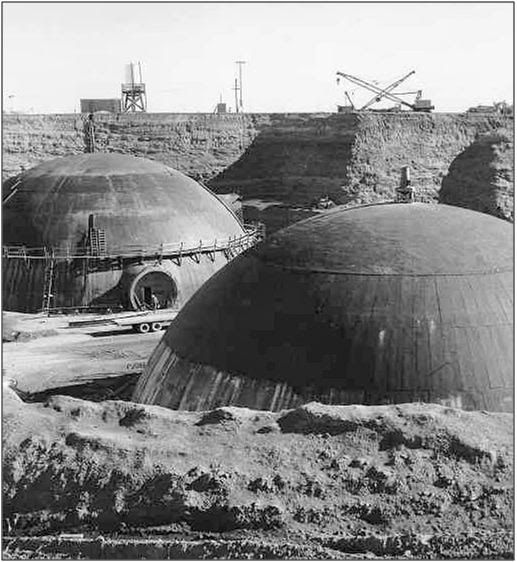
 Figure 6: Three views of the cconstruction sequence of a Titan 1base underway near Live Oak, California circa 1960. This base was a brother to the Yuba City site, and was also under the command of the 851st Strategic Missile Squadron. In the photo at center, the steel reinforced concrete domes of the Control Room and powerhouse are seen after the concrete has been poured.
Figure 6: Three views of the cconstruction sequence of a Titan 1base underway near Live Oak, California circa 1960. This base was a brother to the Yuba City site, and was also under the command of the 851st Strategic Missile Squadron. In the photo at center, the steel reinforced concrete domes of the Control Room and powerhouse are seen after the concrete has been poured.
So, in the middle of one night in 1960, a cow pasture on a farm outside of Yuba City, began its transformation into the construction site of what is, in common parlance, called a “Titan missile silo,” although the word silo is wholly inadequate to describe the effort – or the result. In Figures 8 and 9 below, are schematic renderings of a Titan 1 base which are very close, if not identical to the Titan site near Yuba City. At one end of the complex were the three missile silos; 48.77 meters (160 feet ) deep and 13.41meters (44 feet) in diameter. They were built of steel-reinforced concrete of approximate 1 meter (3 feet) in thickness.
 Figure 7: Photographic sequence showing the deployment of the Titan missile for launch. A massive hydraulic elevator raised the missile and its supporting gantry from the underground silo.
Figure 7: Photographic sequence showing the deployment of the Titan missile for launch. A massive hydraulic elevator raised the missile and its supporting gantry from the underground silo.
Within each silo was a steel gantry that supported the missile, which was perched atop the elevator that carried it to the surface for launch. Each silo was covered by two horizontal doors weighing 125 tons. Adjacent to each silo were the propellant storage and equipment terminal silos, both of which were buried under ~ 6 meters (~ 20 feet) of earth. Several hundred feet away were the Control room and Powerhouse. Both were domed structures built of reinforced concrete and buried ~ 6 meters (~ 20 feet) beneath the surface (Figure 6). The control room was 40 feet high, 100 feet in diameter, and housed the crew, life support stores and the launch control equipment. Nestled between the two buildings was the cylindrical entry portal, 22 meters (72 feet ) deep and 12 meters (38 feet) in diameter, that allowed access to the underground complex. The entry portal contained a huge elevator capable of moving multi-ton loads into and out of the subterranean facility.
At one end of the complex, approximately 396 meters (1,300 feet) from the farthest silo, were the two radar antennas that were part of the missile’s ground-based guidance system, and whose primary function was to house and deploy the ATHENA guidance radar. The pre-microelectronics (analog) Titan 1 did not have on-board inertial guidance/targeting, and instead relied upon instructions from the ATHENA system to reach its target. The antennas were housed in two silos 20 meters (67 feet) deep and 11.6 meters (38 feet) in diameter. The launch crews raised the antennas above ground as they readied the missile for firing. Before each launch, the guidance radar had to be calibrated by acquiring a special target at a precisely known range and bearing. When the missile was subsequently launched, the ATHENA guidance radar tracked the missile and supplied precise velocity range and azimuth data to it’s onboard guidance system. Because of this, each Titan 1complex could only launch and guide one missile at a time.
More than 762 meters (2,500 feet) of corrugated steel tunnel, 2.75 meters (9 feet) in diameter and buried 12 meters (40 feet) beneath the surface, connected all the structures within the complex.
 Figure 8: Layout of a typical Titan 1 Missile site.
Figure 8: Layout of a typical Titan 1 Missile site.
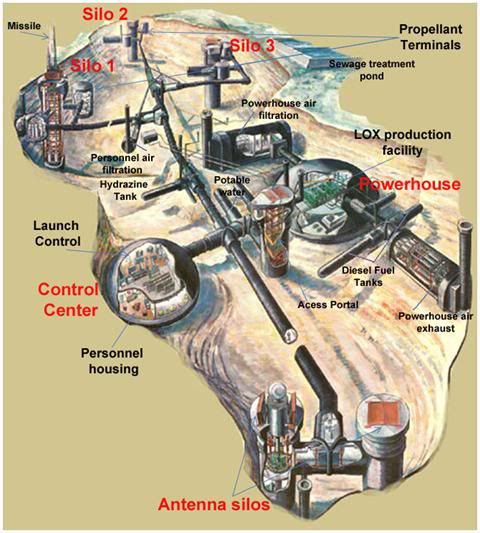 Figure 9: 3-D schematic rendering of the layout of a typical Titan 1 missile site. The antenna silos housed the two ATHENA guidance radars which had to be operational in order to steer the missiles to their targets. The distance between the antenna silos and the most distant missile silo was between 1,000 and 1,300 feet (400 m).
Figure 9: 3-D schematic rendering of the layout of a typical Titan 1 missile site. The antenna silos housed the two ATHENA guidance radars which had to be operational in order to steer the missiles to their targets. The distance between the antenna silos and the most distant missile silo was between 1,000 and 1,300 feet (400 m).
The Powerhouse dome contained the generating plant for the facility. It’s output was such that it could have supplied the 48,000 residents of Yuba City today with all of the electricity they require. This phenomenal wattage was necessary in large measure to power the the air liquification and oxygen liquefaction machinery required to provide the oxidizer for the RP-1 (Refined Petroleum-1 was a highly refined form of kerosene fuel) in the Titan1 rocket. The base, or support “floors” of both of the Control and Powerhouse domes were made from massively reinforced concrete which and were supported on gigantic shock absorbing springs and cantilevers designed to allow the facility to take an indirect hit from a 40-60 megaton (MT) Soviet thermonuclear warhead (to a maximum terrestrial overpressure of 100 psi), and continue operations uninterrupted, thus preserving the capability for retaliation in the event of a Soviet first strike.
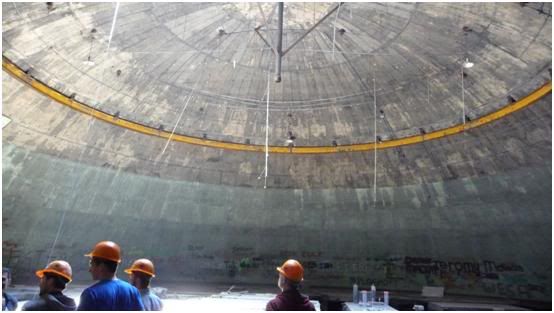 Figure 10: A view of the gutted Powerhouse of a Titan-1 site in Nebraska showing the mammoth scale of its construction.
Figure 10: A view of the gutted Powerhouse of a Titan-1 site in Nebraska showing the mammoth scale of its construction.
Soviet warheads during this era were high megatonnage, primarily because their targeting was so poor. If warhead delivery was off by a kilometer (km), or even a few kms, the target would still be destroyed – albeit at the cost of much greater collateral damage – and a greatly increased yield of radioactive fallout.
A total of six squadrons were equipped with the Titan I. Each squadron was deployed in a 3×3 configuration consisting of a deployment of nine missiles; 3 each in Colorado, Idaho, California, Washington state and South Dakota. the The close placement of the missiles in 3×3 configuration was necessary because they shared a single ground-based radio guidance system. This had the highly undesirable effect of making them more vulnerable to nuclear destruction – especially with the inevitable improvement in the precision of Soviet missile guidance systems. Thus, a total of fifteenTitan I ICBM missiles were ready to launch at any given time. What this meant was that in addition to its nuclear equipped B-52 bomber fleet, the US had at least fifteen 4-megaton nuclear weapons in “reserve” in “superhardened” silos to use as in a final retaliatory strike in an endgame scenario.
The Beast in the Belly of the Earth
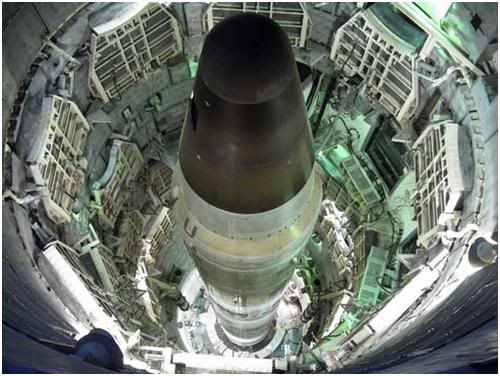
Figure 11: Titan I missile in situ and ready for launch in its blast-hardened silo.
The Titan I was a two-stage, liquid-fueled rocket manufactured by the Glenn L. Martin Company, the first stage of which delivered 300,000 pounds (1,330 kN) of thrust, with the second stage providing an additional 80,000 pounds (356 kN) of thrust. As previously noted, the Titan I utilized RP-1 and LOX as the propellant, the latter of which had to be loaded onto the missile just before launch from an underground cryogenic storage tank, after which the missile was raised above ground on the enormous elevator system, exposing the missile to possible destruction for ~10 minutes before launch. The complexity of the system, combined with its relatively slow reaction time – 15-20 minutes to load, raise and launch the first missile, made it undesirable for rapid retaliatory strikes, and vulnerable to secondary attacks while being readied for launch.
Titan I utilized radio command guidance. An inertial guidance system would have allowed Titan I to proceed to its predetermined target independently without the necessity of using the the ATHENA continuous radio command signals from a ground location, or upon the ability to receive and react to those signals. The inertial guidance system originally intended for it proved un-workable given the state of the art at the time, however, a perfected version was used in the Atlas E missile. The Atlas series was intended to be the first generation of American ICBMs and Titan II (as opposed to Titan I) was to be the second generation deployed; however, a perceived “missile gap” between the US and the USSR led the Air Force to rush the Titan 1 into early operation.
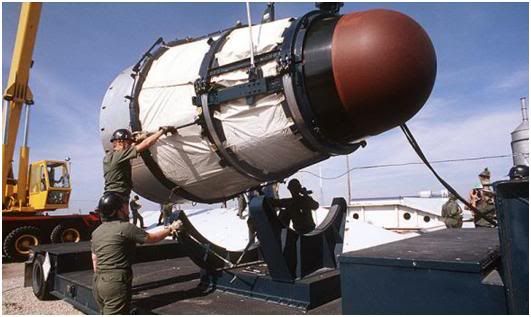 Figure 11: The payload housing of the Titan 1 Missile containing a ~ 4 megaton thermonuclear warhead.
Figure 11: The payload housing of the Titan 1 Missile containing a ~ 4 megaton thermonuclear warhead.
The Titan I had an effective range of 5,500 nautical miles (10,200 km). The warhead of the Titan I was an AVCO Mk 4 re-entry vehicle containing a W38 thermonuclear bomb with a yield of 3.75 megatons, which was fuzed for either air burst, or ground contact burst. The Mk 4 RV also deployed “penetration aids” in the form of aluminized mylar balloons which replicated the radar signature of the Mk 4 RV, hopefully diverting incoming antimissile artillery away from the warhead. The full specifiications for the Titan 1 rocket are given in Table 1.
Mercifully the Titan 1 was never used for its intended purpose. Instead, a number of the Titan 1’s were used to launch exploratory and manned spacecraft into the solar system and into near earth orbit.
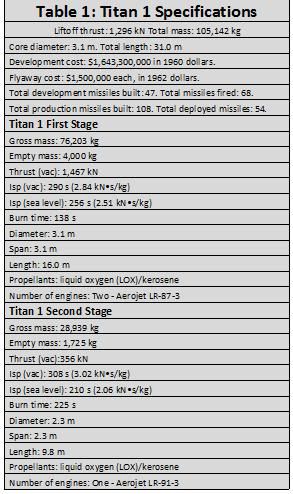
[1] Which would not be discovered for another 150 years.
[2] In 1974 dollars which today equates to $1,092,712.07 in 2010 dollars.
End of Part 1

From http://lesswrong.com/lw/1r0/a_survey_of_anticryonics_writing/ I found a link to http://www.alcor.org/Library/html/coldwar.html which was quite interesting. You remark
> Of course, a variety of more optimistic scenarios can also be offered for consideration. It is possible that successful cryopreservation of a solid organ such as a kidney or liver would soften cryobiological hostility. Certainly it can be argued that successful cryopreservation of the mammalian brain would go a long way towards achieving this end and some both inside and outside the cryobiological community have argued that it will.
Kidneys have been successfully cryopreserved, have they not? Has hostility softened?
The short answers to these questions are “no” and “no.” A kidney has been cryopreserved – a single rabbit kidney. While I believe that result was both real and important, it doesn’t count as science until the last steps in the Scientific Method are achieved: replication and confirmation. Until the original investigators (in this case, Fahy, et al.) replicate the work AND other investigators confirm their results, then no one beyond a small circle of people who have or have had first hand knowledge of the character or the investigators involved, is going to take the work seriously – nor should they. This doesn’t mean that these results are either invalid or useless; in fact, they provide valuable information for future experiments to perfect the procedure.
Going further, it is unlikely, IMHO, that organ cryopreservation will change cryobiological or public perception much, until it is brought to the point of clinical application. As long as it remains a laboratory technique, especially one confined to small organs, such as the rabbit kidney, it is not likely to change the perception of cryonics. — Mike Darwin